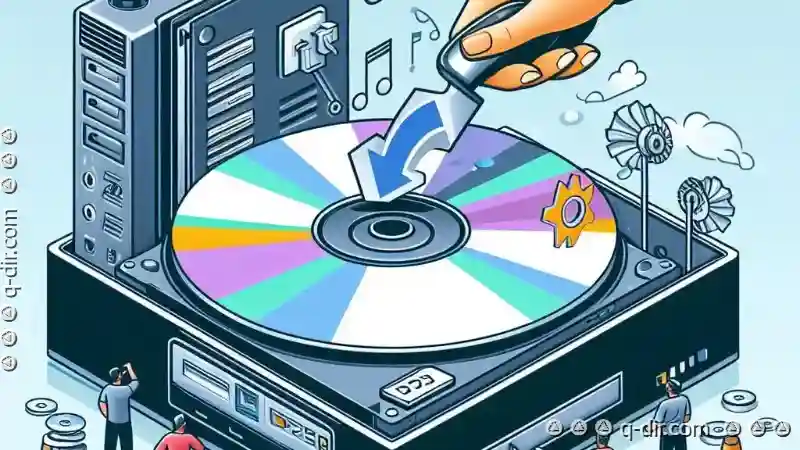Whether you need to backup important data or share content with others, knowing how to handle these tasks efficiently can save time and resources. This ...
 guide will walk you through the steps to paste files from a CD/DVD to your computer using various methods. In today's digital age, transferring files from physical media such as CDs and DVDs to your computer is easier than ever.
guide will walk you through the steps to paste files from a CD/DVD to your computer using various methods. In today's digital age, transferring files from physical media such as CDs and DVDs to your computer is easier than ever.1. Understanding Your Media
2. Method 1: Using an External DVD Drive
3. Method 2: Using a CD/DVD Burner Software
4. Method 3: Using an Optical Drive Emulator Software
5. Conclusion
1.) Understanding Your Media
Before we dive into the process of transferring files, it's essential to understand what you have. Ensure that:
- The CD/DVD is clean and free from scratches or dirt.
- The data on the disc is readable (you might need a diagnostic tool if there are issues).
2.) Method 1: Using an External DVD Drive
If your computer doesn't support reading CDs and DVDs, you can use an external drive for this task. Connect the external DVD drive to your computer via USB or FireWire cable.
Steps:
1. Connect the Drive: Plug in the external DVD drive to a free port on your computer.
2. Open My Computer: On Windows, press `Win + E` to open File Explorer and look for the new drive letter assigned to your external DVD drive.
3. Navigate to the Folder: Open the folder named typically "1" or any other number corresponding to the side of the disc you want to access. Inside this folder, you should see the files stored on the disc.
4. Copy and Paste Files: Select the files you wish to transfer by clicking them with your mouse and pressing `Ctrl + C` (or right-click and select "Copy" Navigate to a suitable location on your computer where you want to paste these files, right-click in that folder, and choose "Paste" or press `Ctrl + V`.
5. Unmount the Drive: Once all necessary files are copied, safely remove the disc from the external drive by closing File Explorer or simply unplugging the device.
3.) Method 2: Using a CD/DVD Burner Software
If you have burning software installed on your computer (often included with applications like Nero or ImgBurn), you can use it to extract files from the disc.
Steps:
1. Install Burning Software: If not already installed, download and install a DVD burning software such as Nero or ImgBurn.
2. Open the Software: Launch the software application.
3. Load the Disc: Insert the CD/DVD into your internal drive and let the software detect it automatically.
4. Select Files to Copy: In the software, navigate through the disc structure (usually represented by a tree view) to find the files you want to copy.
5. Copy and Paste: Select the desired files or folders using checkboxes and click on "Extract" or a similar option to start copying them to your computer's hard drive. Choose a destination folder where you wish to save the extracted files, then begin the extraction process.
6. Finish: Once done, close the software and safely remove the disc from your drive.
4.) Method 3: Using an Optical Drive Emulator Software
For users without physical drives but need to handle CDs/DVDs occasionally, optical drive emulator software can be useful. This software mimics a CD/DVD drive on your computer.
Steps:
1. Download and Install: Download and install an optical drive emulator like Daemon Tools or PowerISO from their official websites.
2. Mount the Disc: Run the emulator software and insert the CD/DVD into your computer as if it were a real drive. The software will recognize the disc and present its contents in a virtual drive on your PC.
3. Navigate and Copy Files: Just like with any other file system, navigate to the files you wish to copy from the virtual drive. Select them using the mouse or keyboard shortcuts (usually `Ctrl + C` for copying and right-click to paste).
4. Extract Files: Once selected, use the software's extraction feature to save these files on your hard drive.
5. Unmount the Virtual Drive: After extracting all necessary files, safely eject the virtual disc from the emulator by closing it in the software interface or simply deleting the mounted image file.
5.) Conclusion
By using any of the above methods, you can efficiently transfer data from a CD/DVD to your computer without needing professional tools like professional video editing suites or specific IT solutions. Remember to always handle physical media gently and maintain proper backups for future use. Whether through an external drive, software utilities, or virtual emulators, mastering these techniques will ensure smooth operations in handling digital content stored on CDs and DVDs.

The Autor: / 0 2025-06-03
Read also!
Page-

Why Moving Files Between Accounts on the Same PC Isn’t Simple
Navigating file management can sometimes be a bit tricky, especially when dealing with multiple accounts on the same computer. While transferring ...read more

Are We Over-reliant on Basic Filters for Complex Data?
They are pivotal in organizing and extracting meaningful insights from vast repositories of information. However, there is a growing debate around ...read more

Why macOS Finder s Filters Are a Half-Baked Solution
MacOS has long been known for its sleek and intuitive interface, including the Finder application which serves as the default file manager. However, ...read more